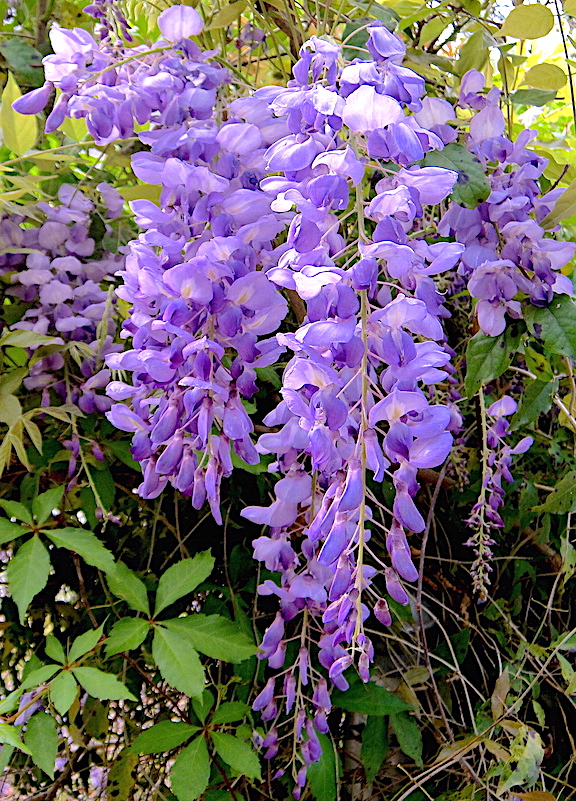
Wisteria in DeLand. The species is usually invasive. Photo by Green Deane
The weather may be chilly still it’s a hot time of year for foraging as many wild fruit species ripen this month. A species blossoming now and rarely covered is Wisteria. The blossoms are edible raw or cooked but the rest of the plant is toxic (though that varies from species to species.) With some two seeds can kill a child. While most Wisteria is considered Asian there is a native species in the Americas, W. frutescens. You can read about Wisteria here.
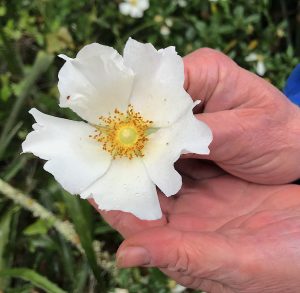
The non-aromatic Cherokee Rose is not native. Photo by Green Deane
Another Asian species sighted recently is one that was once considered native, the Cherokee Rose, which is actually an invasive. Botanically Rosa laevigata (Rosa is from the Greek ῥόδον (rhódon) meaning rose and laevitata or (Levis) is Dead Latin for smooth or polished. It’s a “climbing shrub” as is Smilax and Nicker Bean. Cherokee Rose is a large nearly odorless white bloomer from the low mountains of China and Vietnam. It was carried to the Americas in 1780 and was reportedly cultivated by the Cherokee thus the name. In 1916 at the urging of womens’ clubs it was made the state flower of Georgia and still is. It produces huge rose hips to two-inches long though you have to burn bristles off to use them. And as one might presume the rugged vining shrub is covered with mean prickles. Handle carefully. Sugar from the plant has been used to make wine.
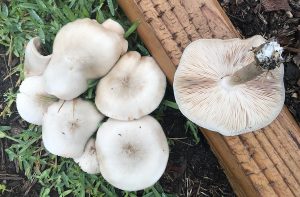
“Deer Mushrooms” are edible. Photo by Green Deane
An edible mushroom taking advantage of the weather is the Deer Mushroom, in this case Pluteus petasatus. These are bunching mushrooms usually growing on old hardwood remains, either logs, stumps, roots or debris. As often is the case the botanical name is more confusing than enlightening. Pluteus can mean shed or penthouse. Petasatus is Dead Latin for wearing a cap (meaning) ready for a journey. A relative is called P. cervinus the latter means deer or stag because of that species’ cap color. It is also sometimes called the Deer Mushroom or Fawn Mushroom. These two are edible but are viewed as marginal. One reason is the cap is mostly gills with little cap material. Sometimes it can have a radish flavor. Spore print is salmon to pink.
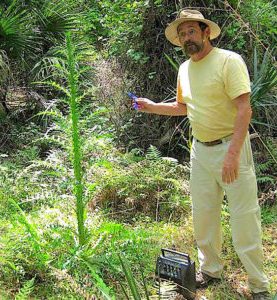
Foraging classes are held rain or shine, heat or cold. Photo by Nermina Krenata
Foraging classes: Many species, especially wild fruits are coming into season.
Saturday, April 6th, Eagle Park Lake, 1800 Keene Road, Largo, FL 33771. Meet at the pavilion near the dog park. 9 to noon.
Sunday, April 7th, Dreher Park, 1200 Southern Blvd., West Palm Beach, 33405. meet just north of the Museum, 9 a.m. to noon.
Saturday, April 13th, Red Bug Slough 5200 S. Beneva Road, Sarasota. 9 a.m. to noon. Meet at the parking lot.
Sunday, April 14th, Bayshore Live Oak Park, Bayshore Drive. Meet at Ganyard Rd and Bayshore. 9 a.m. to noon.
Saturday, April 20th, Blanchard Park, 2451 Dean Rd, Union Park, FL 32817, meet beside the tennis courts, 9 a.m. to noon.
Sunday, April 21st, Wickham Park: 2500 Parkway Drive, Melbourne, FL, meet at the dog park. 9 a.m. to noon.
Saturday, April 27th, Mead Garden: 1500 S. Denning Dr., Winter Park, FL 32789. Meet at the bathrooms. 9 a.m. to noon.
Sunday, April 28th, Colby-Alderman Park: 1099 Massachusetts Street, Cassadaga. Fla. 32706. meet at the bathrooms, 9 a.m. to noon.
Saturday, May 4th, Eagle Park Lake, 1800 Keene Road, Largo, FL 33771. Meet at the pavilion near the dog park. 9 to noon.
For more information on these classes, to prepay or sign up go here.
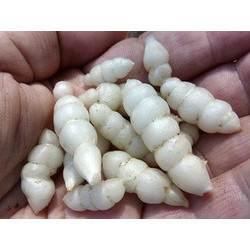
Mild in flavor Betony roots have a radish-like texture. Photo by Green Deane
Found this week, east of Tampa, Florida betony roots. Tasty raw, boiled or pickled, the roots are distinctive and easy to identify. While one can find them in lawns they also like sandy pastures with a thatch layer. Millions of dollars are spent every year trying to poison these into submission. Why not eat them? You can read about Betony here.
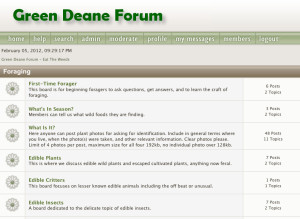
Green Deane Forum
Want to identify a plant? The Green Dean Forum is up and running again. Have you come to dislike Facebook, then join us on the forum. Perhaps you’re looking for a foraging reference? You might have a UFO, an Unidentified Flowering Object, you want identified. On the Green Deane Forum we — including Green Deane and others from around the world — chat about foraging all year. And it’s not just about warm-weather plants or just North American flora. Many nations share common weeds so there’s a lot to talk. There’s also more than weeds. The reference section has information for foraging around the world. There are also articles on food preservation, and forgotten skills from making bows to fermenting food.

You get the USB, not the key.
172-video USB would be a good end of spring present and is now $99. My nine-DVD set of 135 videos has been phased out. The USB videos are the same videos I have on You Tube. Some people like to have their own copy. Most of the 172 USB videos have to be copied to your computer to play. If you want to order the USB go to the DVD/USB order button on the top right of this page. That will take you to an order form.
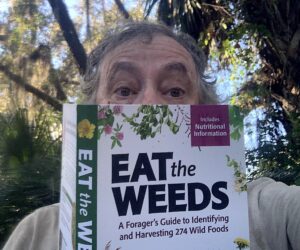
Finally, a physical copy of the book.
Now in its second printing is EatTheWeeds, the book. It has 275 plants, 367 pages, index, nutrition charts and color photos. It’s available in many locations including Amazon. Most of the entries include a nutritional profile. It can also be ordered through AdventureKeen Publishing.
This is weekly newsletter #595. If you want to subscribe to this free newsletter you can find the sign-up form in the menu at the top of the page.
To donate to the Green Deane Newsletter click here.


Just finished your book. A wonderful read! I realized I can now eat my wife’s two-lips… or is that tulips?